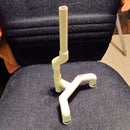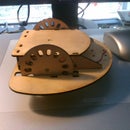Introduction: Self Watering Garden - Using Recycled Water From an Air Conditioner
Did you ever notice that your central air conditioner has a hose that connects to the drain? I never really thought about it until one night I almost tripped because ours went across the basement floor. I cut the hose and placed a trash can there to collect the water... I figured that I would just dump it each day.
I was surprised the next day to find that it had filled the trash can and made a fair sized puddle on the floor, and quite a mess with a stack of papers that was sitting there. After some rough calculations I discovered that about 350 gallons (1300 liters) was being wasted annually. (And that was a conservative estimate!)
I decided to install a pump and use this water for my small garden which was right outside the basement door. All I needed was to figure out how to spread the water evenly for the plants.
We have used this system for several years now... as soon as we move into our new home we will install the updated version described here.
Step 1: The Original Design
I actually built this unit in April of 2000, so I have been enjoying fresh vegetables every year for quite awhile now. As well as the original design worked there were a couple of drawbacks to presenting it here as an instructable.
The cross pieces on the original unit were made from a 4-way Tee section that I had modified on my lathe. Since not everyone has access to a lathe to machine the parts, and because I am getting a new house and will rebuild the system anyway, a new way of doing this was devised.
Another change that was made was the area where the water left the house and went to the A-Frame... I had used flexible tubing but after a few years it became brittle in the sunlight. I switched to ridged PVC, but this made the unit difficult to move around. Both of those problems were solved with the new design.
Step 2: Starting at the Air Conditioner...
The first step is to install what is called a condensate pump to get the water from where it is now to where we want it. The pump has a built-in tank and a float valve. When the tank is about 95% full the pump will come on and continue until the tank is empty. Depending on your pump this will usually be about a gallon (4 liters) at a time.
This really works out well because instead of your plants getting a great deal of water once in the day... they get a small watering several times all day long. Since the water is from an air conditioner it tends to be very cool... this helps keep the plants from overheating too. Before this project I could barely keep the plants alive... now... I have to cut them back all summer!
The pump is placed lower than the output of your air conditioner system and a flexible tubing is run from the pump to the wall where we drill a small hole for the connection to the outside.
Step 3: Run the Tubing to the Outside Wall...
Once you get the pump installed you will need to run some flexible tubing from the pump to the place where you will exit the house to the garden. On the original project we just drilled a hole in the wall and put the hose through it. This worked great for the first year, but then the hose we used cracked (outside) from exposure to the UV from the sun. In this version we will connect to a brass hose connector and run outside... then connect to another hose connector. This will allow us to have flexibility and easy repair should the outside hose ever need replacement.
Be sure that the path you take from the air conditioner to the outside wall does not lay directly on any electrical boxes, lights, or run across anything that could melt it such as the flue for your heater. Likely you won't have any problems finding a good path, but I wanted to be sure the design is safely installed!
Step 4: Moving Outside...
Once you get the hose to the place where you want to go outside, we need to drill a hole and provide some sort of path for the water that allows us the ability to disconnect the hose for maintenance, and that does not allow insects to enter the building.
The original design just had the hose outside, then it was updated to rigid PVC which worked but was not as easy to relocate and maneuver. The new design is very flexible and the whole unit can be moved to allow you full access to your garden if you need it for weeding and such.
We used a fitting designed to go onto a 1/4 inch ID (6mm) pipe nipple long enough to penetrate the wall and leave some threads out. We didn't want the fitting to scratch up the paint on the wall but we wanted to be able to really tighten it down to keep it secure and keep insects out.
The design was simple... add washers and tighten down the fittings to sandwich it all together into a solid attachment point for the hose.
Step 5: Let's Build a Frame...
So now we have a source of water outside, let's do something with it. The A-Frame is built from 2 inch (60mm OD) PVC pipe. The result is a very sturdy design that does not need the use of anything more than PVC glue and a hand saw to construct.
Once the two side units are assembled the water tube is press fit (friction fit) into the top Tee connections. As it works out... the fit is very good.
Step 6: The Water Bar Assembly...
So you have the A-Frame built or you have another existing frame that you can suspend the water bar from... now we need to build the bar.
The bar is very easy to build, simply cut your two long peices to the proper length and glue them into the Tee connector as shown.
Glue the two end caps onto the tube and allow to dry.
Drill a series of 1/16 (1.5mm) holes evenly spaced every 2 to 3 inches (50 to 70mm) down the length of the pipe. If you use a slightly larger diameter drill, say 1/8 inch (2.5mm), then space them every 6 to 8 inches (150 to 200mm) apart.
For tomatoes I used a 6 inch (150mm) spacing... for beets and peppers I used 4 inches (100mm)... it's not that critical.
If you hang the water bar from a structure you may need to support the feed hose so it doesn't move the bar off-axis. It's good to use a level to be sure everything is watered well and evenly.
Step 7: Enjoy!
That concludes the construction of this project... now you are ready to plant your flowers or veggies and enjoy the benefits of this automatic watering system. I was going to calculate how much energy the system uses... but frankly I never saw any noticeable increase in the utility bills. I did notice that our water bill was almost 10% lower from not needing to water the plants daily.
All in all this was a fun and benifical project... it saves precious resources, makes you work less in the garden, and because the water contains no chlorine... your vegetables taste much better and the plants don't yellow as much.
Runner Up in the
Earthjustice United States of Efficiency Contest
Participated in the
Epilog Challenge














